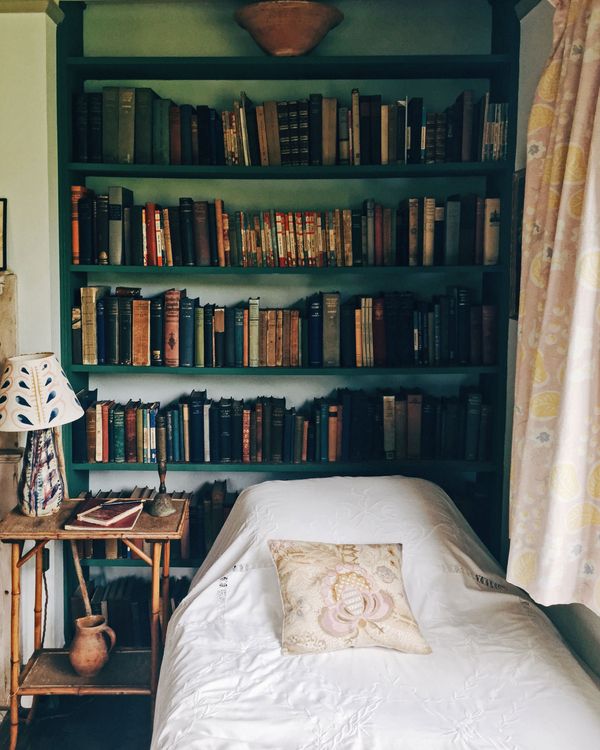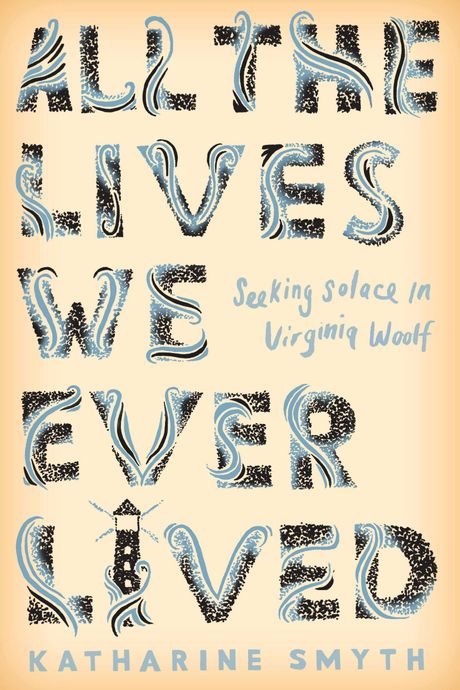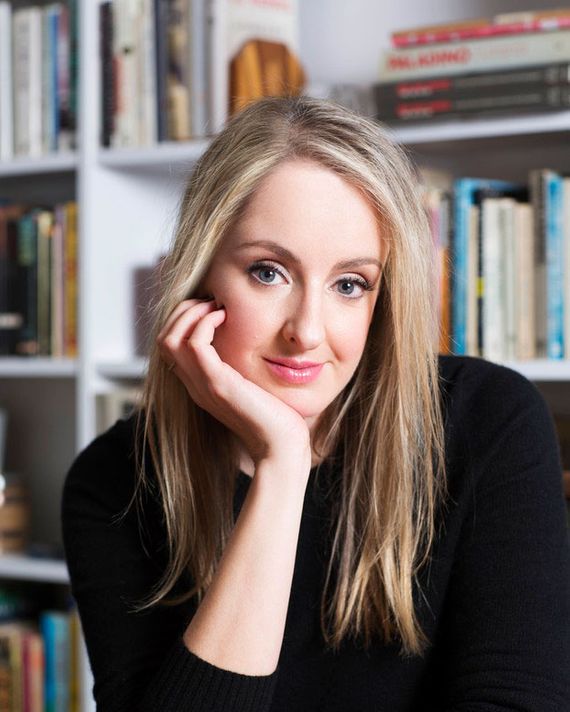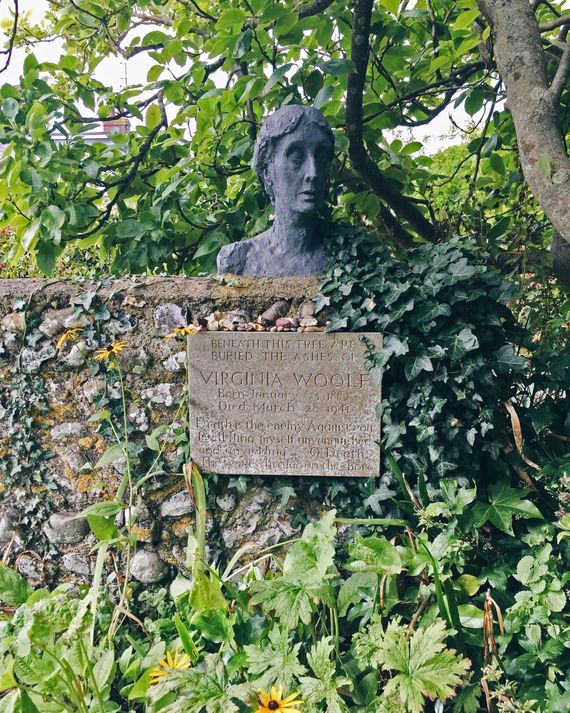
No door connects Virginia Woolf’s bedroom to the rest of Monk’s House, the Sussex country retreat not far from the river in which she drowned herself in 1941. Instead, she’d enter her private chamber by leaving the kitchen, climbing some stone steps, and walking down a brick pathway. The room has its own energy — the air moves more freely and breathing comes easier. The bed is pressed up against a sea-green bookshelf; her head rested among words. The fireplace is painted by her sister Vanessa with a seaside scene reminiscent of the landscape that inspired To the Lighthouse.
Three years ago, I spent four days living as close to that room as a civilian possibly can. My husband and I had taken a three-month-long pseudo-sabbatical in England, and I’d booked us into a roster of slate-shingled bolt holes covered in domineering rosebushes. In Sussex, we stayed in a small studio that the National Trust — a restoration agency that has a way with cream paint — had converted from a storage area into a mini-send-up of Monk’s House, down to the paisley swirls on the lampshades. From our kitchen window I could watch other tourists coming down the road and pretend I wasn’t one of them.
I had never felt so close to greatness, so capable of my own, so enmeshed in the textual richness of life. I read Elizabeth Jane Howard’s Cazalet Chronicles, determined to understand what the boom of German fighter planes over Sussex might have done to Woolf’s already susceptible psyche. Those four days, spent climbing the hills around the River Ouse, wandering into the house at will, playing bowls in the long warm light of a September dusk, were some of the best of my life. Except it wasn’t my life I was living, but a cozy simulacrum of Woolf’s.
Millions of us visit writers’ houses every year, called to slide our palms down the wooden handrail that Keats’s inky hands once touched, to surreptitiously snap a photo of the view Dickinson had while scribbling. In Woolf’s house — or rather, next to it — I could finally fathom the solitary splendor of her life in the country, could understand how the views into her own garden informed the riotous infusion of flowers in her work. It was as close as I might get, outside of her most intimate work, to understanding the life she lived. It felt exhilaratingly close, but was it close enough? Did it really help me understand?
“Perhaps there is one book for every life,” Katharine Smyth begins in her new memoir, All the Lives We Ever Lived: Seeking Solace in Virginia Woolf, “one book with the power to reflect and illuminate that life … while also helping us to clarify and catch hold of its most vital moments. For me, that book is [Woolf’s] To the Lighthouse.”
Smyth uses that one book for her life as the life force for her own book. All the Lives is a memoir, yes, but also part biography, part lit crit, part adulation — the story of the emotional turmoil of her father’s alcoholism, cancer diagnosis, and eventual death, organized as a paean to a British novel written in the 1920s.
It’s a bold plan — to compare your life to one of a great work of modern literature, to adopt one of history’s great minds as the singer of your own story — especially since Smyth’s life bears only a passing resemblance to Woolf’s. Raised in middle-class New England gentility by two architects, Smyth is an only child, and a daddy’s girl, whereas Woolf was raised in a prosperous Victorian London family, the second of four children, and eternally devoted to her mother, who died just as Woolf was entering her teen years. Smyth’s father died when she was in her early 20s. She attended Cambridge, as Woolf’s father and brothers did. But in A Room of One’s Own Woolf recalls being told, on a visit there, that “ladies are only admitted to the library if accompanied by a Fellow of the College or furnished with a letter of introduction.”
And yet, those differences only add contrast to Smyth’s connective tissue. Let’s pause to recognize how remarkable it is that a young writer can convincingly buddy up with one of the greats in her first book without it coming off as a juvenile fanzine. There’s an entire genre of books premised on literary worship, some successful (Sarah Bakewell’s Montaigne homage How to Live, John Kaag’s American Philosophy: A Love Story) and others less so. Most writers are, we must admit, zealous readers above all else, in constant mental conversation with what has come before us. The temptation to build our work explicitly on theirs is too great — too easy. All the Lives could have read as gush; instead, Smyth reaffirms the value of novels as existential guideposts.
Woolf might agree with Smyth that To the Lighthouse is her defining work. Like Henry James’s Portrait of a Lady, it’s neither as conventional as the early work nor as tough to penetrate as the late stuff. More than anything, it’s the story of childhood’s indelible impressions, of the way a flash of light across the bedroom ceiling can impress a sense of safety on a child. And it’s about what happens when the solidity of that room, that light, and that childhood disintegrate like sand between your fingers after a cataclysmic death. It’s Woolf’s auto-fiction, before such a term existed.
The story of the Ramsay family is told in three parts. In the first section, “The Window,” Mr. and Mrs. Ramsay and their eight children — a mostly happy clan — are gathered at their seaside home with friends. James, their youngest son and a devoted admirer of his mother, begs to be taken on a day trip to the lighthouse. Friends and family pass through the house: their insights, worries, and preoccupations shifting into focus. In the second section, “Time Passes,” nearly ten years go by, and two of the Ramsay children die, along with their mother, the bulwark of the family. The last section, “The Lighthouse,” sees the remaining Ramsays finally taking that long-put-off trip to the lighthouse, reckoning with the new shape of their family. It’s both a monument of modernism and an open wound of grief, a novel with a hole at the center of it where the protagonist ought to be.
“One of the wonders of Woolf’s novel,” Smyth writes, “is its seemingly endless capacity to meet you wherever you happen to be, as if, while you were off getting married and divorced, it had been quietly shifting its shape on the bookshelf.” The shape it takes in All The Lives is Smyth’s own unrelenting desire to understand her father. Just as Woolf re-creates her mother on the page (her sister Vanessa wrote of Mrs. Ramsay, “it is almost painful to have her so raised from the dead”), Smyth re-creates her father in sections that parallel To the Lighthouse. In the first, she walks readers through his meet-not-so-cute with her mother, their strained relationship, and his hot-and-cold personality. In the second section she chronicles the disintegration of his body as cancer makes itself at home in his organs and eventually kills him. The third part dwells on Smyth’s grief and its manifestations, along with her own return to the waterfront home she once lived in with her parents.
Smyth’s beautiful debut is more tightly strung together than you’d imagine a memoir-cum-literary-requiem could be. It is innovative, like Woolf, in its power of association and its ability to transform the intangible nature of grief into a warm, graspable, fleshy mass. When she writes, “I thought how difficult it was to believe in death for more than a few minutes at a time,” it sounds like a line that Clarissa herself might have thought in Woolf’s other masterpiece, Mrs. Dalloway. And Woolf surely couldn’t find fault with the following observation, literary analysis at its most personal: “It is only now that I realize just how accurately ‘Time Passes’ — in the indifference that it flaunts, in the desperation it arouses, even in the boredom that it promises — replicates the experience of severing from the person we love.”
What Smyth doesn’t do is condense Woolf’s work into a motivational magnet, or ask it to do all the heavy lifting. She tells of the 14 long years she spent trying to save her father’s life; the blessed four-year window of remission; the exasperation of her parents’ feuding over his drinking; the odd disjointment of her father’s eventual death after years and years of waiting for it. To the Lighthouse laps up gently next to it, flitting in and out like illuminated memories. This, we might imagine, is one of the ways Woolf hoped readers would use her emotionally autobiographical fiction: to find affinity with fellow sufferers in the world.
Where All the Lives We Ever Lived really makes its mark is in its living embodiment of an author and her work. Smyth, like many devoted fans, wants to crawl inside Woolf’s life and story, to poke around and see which bits resonate most profoundly. She doesn’t crib from Woolf so much as she uses Woolf’s genius as a tool for understanding her own grief. It’s tempting to find snobbish fault with Smyth’s use of literature as instruction manual, but she’s only performing more vigorously and professionally what we all do with our favorite and most cherished writers. Smyth is resurrecting Woolf through her novel — finding the kinship between reader and writer that rests in storytelling.
It’s fitting that Smyth both begins and ends her memoir by discussing Woolf’s homes. The novelist fussed over her houses and luxuriated in them, and she returned again and again to the idea of how our homes shape us — most pointedly in To the Lighthouse, where the Ramsays’ retreat stands in for the summer home in St. Ives, Cornwall, that Woolf’s family owned before her mother’s death. “If life has a base that it stands upon,” Woolf wrote in her memoir A Sketch of the Past, “if it is a bowl that one fills and fills and fills — then my bowl without a doubt stands upon this memory. It is of lying half asleep, half awake, in bed in the nursery in St. Ives.”
When Smyth visits that place — known as Talland House — to “see what it might teach [her] … about … its author but also about those homes by which we measure happiness,” she writes that she was feeling “as dreamy as Virginia about the coming journey.” But the reality is disappointing. Talland House is privately owned and closed to the public, and “its ivory walls were streaked with rust, and a tangle of exterior metal staircases … crept up the rear. A Ford Focus was parked in the driveway.” Modernity has crashed into Smyth’s vision in the form of an American hybrid. It isn’t until a gardener invites her to look around back that she recognizes the house Woolf described.
On our own idyllic trip to England, we spent a week in St. Ives, lured by the cliffside walking paths and crashing sea views. Although not quite stuck in time, Cornwall, jutting its boot out into the Atlantic, is still very much itself, near the same as it might have been in 1899, when Woolf was the same age as young James Ramsay. On an adventure quite like Smyth’s, I stalked St. Ives’s streets until I found Talland House. I, too, shuddered at its current state. For a place so foundational to Woolf’s writing — to her sense of self — there was nothing of the original left.
Still, there’s something fitting about Talland House’s lapse as a site of Woolf pilgrimage. It became more of an idea for Woolf than a real place. She went back as an adult, though she never regained entry to the house itself — she stared placidly through the fence with her siblings: They “hung there like ghosts.” Cornwall still held a magical quality for her, but Talland House held only what her husband Leonard called “the ghosts of her childhood.”
Monk’s House, on the other hand, was Virginia’s avowed “for ever” home, alternately a respite from London and a lonely plot of land that made her homesick for the trill of city life. She thrilled over new purchases (many made with money from her better-selling books) like a hot-water system and an adjoining garden plot. After their London flat was bombed during the blitz, the Woolfs made Monk’s House their full-time home. It’s the home she walked out of the day she drowned herself, leaving Leonard and her sister Vanessa notes on the mantel. It’s the garden where she and Leonard are both buried, now with placards and busts to mark the spot.
Smyth also ends her story at Monk’s House. Leonard and Virginia, she writes, are “the phantom pair who haunt its halls.” Smyth comes to consider Monk’s House the place to visit if you want to understand Woolf — to embody her spirit. It’s a fruitless enterprise, of course. I’ll never know Virginia, and Smyth will never know her, either. Perhaps the desire itself is overeager, even unsavory. Woolf suffered horribly at Monk’s House, walked out its back door and into the river forever. Who are we to play at bowls in her yard or genius in her bedroom, to piggyback on the grief for her mother that first launched her into madness?
And yet, Woolf understood and respected that voyeurism is at the heart of literary creation. Smyth writes about To the Lighthouse that “in one sense, the whole book is about her relentless efforts to pin [Mrs. Ramsay] down — to get inside her, to become her, even — and in so doing, to know her absolutely.” In All the Lives We’ve Ever Lived, and in our visits to the haunted homes of the writers we cherish, the quest is not so different. As Woolf wrote in “How Should One Read a Book?,” “We linger in front of a house where the lights are lit and the blinds not yet drawn, and each floor of the house shows us a different section of human life in being.”




